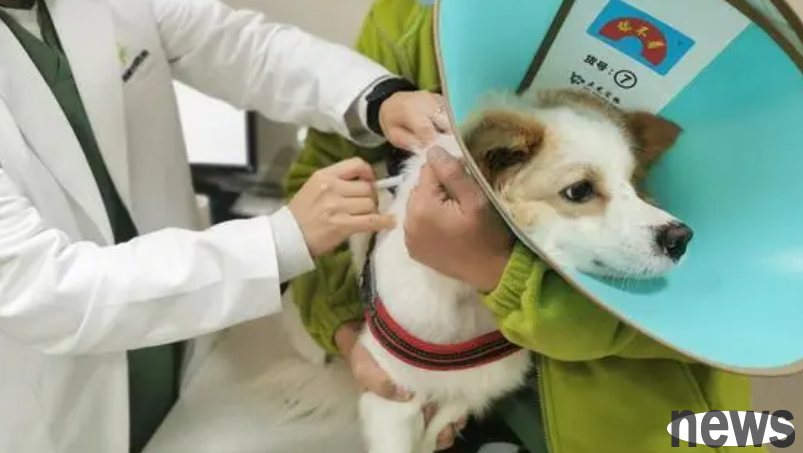Excessive vaccination of pets has an impact on their health!
The pet vaccine is administered once a year, which seems to have become a routine for domestic vaccine injection frequency. But have you ever questioned such frequent vaccine injections? You should know that most of us humans will only receive various types of vaccines at the beginning of birth, and all vaccinations will be stopped after that, and pets need to be given a large amount of vaccines every year. Is this really reasonable? In fact, the effective cycle of vaccines is much greater than one year.
Human vaccine injection cycle
In addition, parents who have been raising pets for many years should have also discovered that no matter how old or how many pounds your dog/cat is, the amount of vaccine injection is the same and no adjustment has been made. In other words, the dose of 3 or 4 catties of Teddy is the same as 100 catties of Alaska.

Why are you advised to reduce the frequency of vaccination?
According to British experts' research, 10% of 2,000 cats and dogs will have adverse reactions (the negative reaction claimed by vaccine manufacturers to the outside world is only 0.015%), especially the probability of smaller sizes is ten times higher than that of larger sizes, which is enough to prove that standard vaccine doses are serious overdose for small cats and dogs.
And the adverse reactions caused by this excessive vaccine are mild, with reduced appetite, sneezing, local swelling at the vaccination site, severe cases continue to vomit, diarrhea, skin itching and even difficulty breathing, and even worse cases die directly. To take a step back, even without these adverse reactions, multiple vaccine injections have overwhelmed their immune systems.
The source is still the rule that "vaccine injections are given every year", so where does its basis come from? Dr. W. Jean Dodds, president of the Public Welfare Animal Red Cross (one of the pioneers of the debate on vaccine issues), once said, "With the emergence of the vaccine problem, they began to study how vaccine injections are produced every year. After years of research, they found that the US Department of Agriculture and drugmakers issued this "suggestion" more than 20 years ago, and it has no scientific basis."
In other words, for many years, the veterinary community has insisted on vaccinating pets every year, just because of inertia? Manufacturers even printed every year on medicine bottles, which has led to new doubts and protests being opposed. This operation...
In fact, in W. Jean Before Dr. Dodds made this statement, the University of Pennsylvania in 1991 was the first to discover this. They found from many cases that rabies vaccine injections caused a malignant inflammatory response to subcutaneous tissues, which could induce cat sarcoma cancer. At the same time, the University of California, Davis also confirmed the incident and found that the feline leukemia vaccine can induce feline sarcoma cancer more significantly than the rabies vaccine.
This discovery led veterinarians to reexamine the injection cycle problem and found that the long-term repeated injection of vaccines in cats will lead to 1/1,000 chance of sarcoma cancer. In the United States alone, there are 22,000 cases each year. In addition, other vaccine reactions were discovered one after another, such as endocrine diseases, allergies, arthritis, tumors, epilepsy, etc. Until 1995, the American veterinary journal finally concluded that "there is almost no scientific evidence to support the "annual injection" marked on the vaccine bottle."
Note: American feline practitioners have put forward several suggestions for reducing the risk of related tumors in the published cat vaccine guidelines;
1. Inject only when the risk of infection is high, but the more injections are, the greater the risk of tumors;
2. Reduce the frequency of injections, such as feline plague, feline herpesvirus and feline calicivirus, which must not be higher than once every 3 years;
3. Change in intramuscular injection to subcutaneous injection, and tumor problems can be detected as soon as possible;
4. Injection The area is changed to the end of the limbs to prevent the spread after the tumor (can be amputated);
The topic of the vaccine itself is a cliché. The most important thing for us is to know what the vaccine is? What role can it play? When a vaccine is made by artificial means, it can prevent infectious diseases by making an immune preparation that can prevent infectious diseases. It is like making a preparation in advance. Before you can react, your shadow guard has already let it fall down.
vaccines are mainly divided into weakly live vaccines (low poison) - Interway and inactivated vaccines - Miaosando. Weakly live vaccines contain inadequate toxicity, which can make cats and dogs produce antibodies without being infected. The most common ones are the five-unit dogs and the three-unit cats; the inactivated vaccine, as the name suggests, will all die if the virus is dead, and there will be no chance of infection. The most common ones are rabies vaccines, flu vaccines, etc.
Although judging by name, the inactivated vaccine seems to be safer. But in fact, from the perspective of immune effect and long-term health, weakly active vaccines are better than inactivated vaccines, but for cats and dogs who are in the disease stage or are weak, it is more dangerous and will only aggravate the condition. This is also the reason why veterinarians give them physical examinations before getting the vaccine.
Here I would like to remind everyone not to get vaccinated by yourself. Because domestic vaccine smuggling is very serious, it is easy to lose its effect if it is not preserved well, which is useless for cats and dogs. Whether it is injecting the vaccine in a hospital or a pet store, it is best to have the doctor use cat plague test strips in person to test the effectiveness before injection. If it is positive, it will be effective.
According to the latest revised American Animal Hospital Association Canine Vaccine Guidelines and published by the Canadian Veterinary Association, the core vaccine must be injected.

Note: The rabies vaccine is based on the opinions of Dr. Lisa A Pierson. If the cat is kept at home and is not in an epidemic area, there is no need to be injected with rabies vaccine.
For example, cat leukemia vaccine, cat abdomen vaccine, cat AIDS vaccine; dog kennel cough, canine Lyme disease, dog leptospira, etc., all belong to non-core vaccines. For healthy cats without special needs (potential risks or genetic diseases, etc.) are not recommended for injection. These diseases cannot produce sufficiently potent immune bodies, whether they are vaccinated or natural infection.. It is worth mentioning that feline herpes virus. If you have been infected with this disease during a kitten, you will carry this virus for several years or even for your life. Repeated injections are just in vain. In addition, cat leukemia is the same. After the first year of immunization and the next year, it will no longer require injections in your life.
As for dogs with Lyme disease, if your dog often goes to the wild or living areas that are endemic to these diseases, vaccination will still outweigh the disadvantages.
Authoritative experts recommend the vaccine injection process
At present, there are many controversies about whether cats need to get rabies vaccine, and how often they get it. So taking cat vaccine injection as an example, three different injection plans are provided below, from: the founder of the
Charity Animal Blood Bank, director of the Blood Research Laboratory of the Wattsworth Research Center, and also serves as executive director of the Human Blood Transfusion Council of New York; the expert of the Canine Vaccine Team and the American Association of Feline Veterinary Practice (AAFP) Cat Vaccine Team, and one of the most authoritative persons in animal immunology, Ronald D. Dr. Schultz;
AAFP, the American Association of Feline Veterinary Practitioners is a professional organization composed of veterinarians (founded in 1971, dedicated to improving the quality of life of feline pets and promoting related medical progress);
Once again, the above vaccines are only for domestic cats. If you do not go out and are not in an epidemic area, you do not need to get rabies vaccine. As for the vaccine injection problem of stray cats, it is best to inject a core vaccine after short-term observation and isolation.
If it is found that the vaccine is obviously injected but still sick, it is usually a "technical failure", such as the age of the first immunization is too young, the infection is present before the injection (or it is immediately infected after the injection, and the vaccine will not immediately play a protective role, and there is a certain time to start), the pet is in an unhealthy or malnutrition state during the injection of the vaccine, and the problem of congenital immune system defects. In these cases, many of the pets infected with the disease do not fail the vaccine, but the vaccine itself (weakly live vaccine) caused the disease or the critical 16-18-week vaccine injection was missing during the first immunization.
Scenarios where special vaccination is required
Since the above mentioned vaccination issues for stray dogs, we will continue to talk about how pets in some special situations should be vaccinated.
For pets taking anti-cancer and chronic inflammatory hormone drugs (such as prednisolone) or immune system inhibitors (such as tukocin, cyclosporine), these drugs will change the results of the body's contact with drugs, which will have an impact on the immune system. If the vaccine injected is a weakly live vaccine, it will not only not have any effect, but may also cause infection, so it is not recommended to inject vaccine.
For pets with immune system diseases or chronic diseases (such as cancer, diabetes, kidney disease, heart and lung disease, etc.), their immune systems are no longer as strong as before they were infected. Perhaps they need a "strengthening needle", but whether these reinforcement needles can help them better resist infection is not yet shown, and we don't know. However, if you want to get the vaccine, it is recommended to choose the "inactivated vaccine". A weakly live vaccine may only aggravate the condition.
For elderly pets, because resistance weakens with age, even if the "enhancing needle" is re-used, its strength may be greatly reduced. The comparison of immune effect is the link between the strength of the fish's own immune system. If you think you want to get the shot, then the same reason as the previous article, give priority to inactivated vaccines.
Things that are more important than vaccination
The physical examination is conducted every year to understand pet parasites, tumors and comprehensive health issues. It is not to let everyone not get vaccinated, but to encourage everyone to see more whether their babies need multiple injections. If you cannot determine whether antibodies still exist in the cat and dog, you can do a serum test and you can understand it by drawing blood in one blood. The effective protection period of the vaccine is nearly 7 years. If indoor cats do not go out or contact other animals, it is recommended not to inject too much. Dr. Becker believes that excessive vaccination is directly related to the worsening cat health.
Try not to go to pet hospitals/pet shops with large passenger flow, and do not go to areas where pet infections occur. If you come into contact with other animals, just in case, just wait for the time being, change your clothes and wash your hands as soon as possible, especially after contacting stray cats and dogs, because of outdoors, there may be a large number of bacteria, bacteria, etc. on them.
Finally, I would like to remind everyone that if your cat or dog has had a serious and life-threatening vaccine reaction, please do not get a vaccine again!




